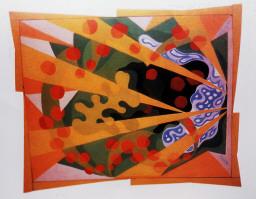Italy is gearing up for a string of events paying tribute to Futurism, as the country's influential 20th-century art movement approaches its 100th birthday.
Three exhibitions are planned for next year, grouped under the single banner of Futurismo 100, which will revisit traditional interpretations of the movement through comparisons with other movements.
The first show gets under way on January 17 in the northern Italian town of Rovereto.
The Trento Museum of Modern and Contemporary Art will host the event, which will contrast Futurism with important movements in Germany and Russia.
Links with Germany's Expressionist movement will be explored through work by Marc Chagall, Wassily Kandinsky, Paul Klee and August Macke.
A 1914 trip to Russia by the poet Filippo Tommaso Emilio Marinetti, who penned Futurism's founding manifesto, will be used as a springboard for considering ties with Russia's Cubo-Futurism movement.
The second exhibition, timed to coincide with Venice's prestigious Biennial, will open in the Correr Museum on June 5.
This event will concentrate on abstract art as a concept, and the various meanings ascribed to the term during different periods.
It will compare the work of Giacomo Balla and other European artists of his day to look at the shift away from abstract techniques of Cubism.
Piet Mondrian, Francis Picabia, Robert Delaunay and Marcel Duchamp will all be featured alongside Italy's Futurists.
Milan, considered one of the driving forces in Futurism, will conclude the triple initiative with an exhibition opening in Palazzo Reale on October 15.
This final event will pay homage to Umberto Boccioni, while also looking at Futurism's most intense period through the work of Carlo Carra' and Luigi Russolo.
The Milan show will contrast the Italian artists' work with Expressionist, Cubist, Dadaist and Constructivist pieces from across Europe.
Outside the Futurismo 100 initiative, Rome's Quirinale will be hosting its own exhibit on the legendary movement after it wraps up in Paris early next year.
The show, which moves on to London's Tate afterwards, invites visitors to re-evaluate the impact the movement had on modern art and features all its major protagonists - Balla, Gino Severini, Boccioni, Carra', Russolo and Mario Sironi - as well as minor stars such as Fortunato Depero and Enrico Prampolini.
Moscow is also marking the centenary with a 200-work exhibition at the Pushkin Museum, commemorating the impact of Italian Futurists and their Russian counterparts on modern art.
FUTURISM LAUNCHED IN 1909 WITH PUBLICATION OF MANIFESTO IN FRENCH DAILY.
Futurism was officially launched with the publication of a manifesto by Marinetti in French daily Le Figaro on February 20, 1909.
The manifesto expressed the Futurists' key ideas - a love of technology, industry and speed, and a loathing of the past.
Futurism's rampant colours and violent energy extolled the merits of a new, technologically advanced age.
Art historians have long recognised the part played by Futurism in shaking up the sleepy art world of the turn of the century, according them an honoured place between the Impressionists and the Cubists.
